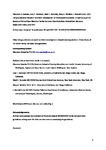Using Qualitative Research to Inform Development of Professional Guidelines: A Case Study of the Society of Critical Care Medicine Family-Centered Care Guidelines
| dc.contributor.author | Coombs, Maureen | |
| dc.contributor.author | Davidson, JE | |
| dc.contributor.author | Nunnally, ME | |
| dc.contributor.author | Wickline, MA | |
| dc.contributor.author | Curtis, JR | |
| dc.date.accessioned | 2018-12-16T12:05:24Z | |
| dc.date.available | 2018-12-16T12:05:24Z | |
| dc.date.issued | 2017-08 | |
| dc.identifier.issn | 0090-3493 | |
| dc.identifier.issn | 1530-0293 | |
| dc.identifier.uri | http://hdl.handle.net/10026.1/13041 | |
| dc.description.abstract |
<jats:sec> <jats:title>Objectives:</jats:title> <jats:p>To explore the importance, challenges, and opportunities using qualitative research to enhance development of clinical practice guidelines, using recent guidelines for family-centered care in the ICU as an example.</jats:p> </jats:sec> <jats:sec> <jats:title>Methods:</jats:title> <jats:p>In developing the Society of Critical Care Medicine guidelines for family-centered care in the neonatal ICU, PICU, and adult ICU, we developed an innovative adaptation of the Grading of Recommendations, Assessments, Development and Evaluations approach to explicitly incorporate qualitative research. Using Grading of Recommendations, Assessments, Development and Evaluations and the Council of Medical Specialty Societies principles, we conducted a systematic review of qualitative research to establish family-centered domains and outcomes. Thematic analyses were undertaken on study findings and used to support Population, Intervention, Comparison, Outcome question development.</jats:p> </jats:sec> <jats:sec> <jats:title>Results:</jats:title> <jats:p>We identified and employed three approaches using qualitative research in these guidelines. First, previously published qualitative research was used to identify important domains for the Population, Intervention, Comparison, Outcome questions. Second, this qualitative research was used to identify and prioritize key outcomes to be evaluated. Finally, we used qualitative methods, member checking with patients and families, to validate the process and outcome of the guideline development.</jats:p> </jats:sec> <jats:sec> <jats:title>Conclusions:</jats:title> <jats:p>In this, a novel report, we provide direction for standardizing the use of qualitative evidence in future guidelines. Recommendations are made to incorporate qualitative literature review and appraisal, include qualitative methodologists in guideline taskforce teams, and develop training for evaluation of qualitative research into guideline development procedures. Effective methods of involving patients and families as members of guideline development represent opportunities for future work.</jats:p> </jats:sec> | |
| dc.format.extent | 1352-1358 | |
| dc.format.medium | ||
| dc.language | en | |
| dc.language.iso | eng | |
| dc.publisher | Ovid Technologies (Wolters Kluwer Health) | |
| dc.rights | Attribution-NonCommercial-NoDerivatives 4.0 International | |
| dc.rights | Attribution-NonCommercial-NoDerivatives 4.0 International | |
| dc.rights | Attribution-NonCommercial-NoDerivatives 4.0 International | |
| dc.rights | Attribution-NonCommercial-NoDerivatives 4.0 International | |
| dc.rights | Attribution-NonCommercial-NoDerivatives 4.0 International | |
| dc.rights | Attribution-NonCommercial-NoDerivatives 4.0 International | |
| dc.rights.uri | http://creativecommons.org/licenses/by-nc-nd/4.0/ | |
| dc.rights.uri | http://creativecommons.org/licenses/by-nc-nd/4.0/ | |
| dc.rights.uri | http://creativecommons.org/licenses/by-nc-nd/4.0/ | |
| dc.rights.uri | http://creativecommons.org/licenses/by-nc-nd/4.0/ | |
| dc.rights.uri | http://creativecommons.org/licenses/by-nc-nd/4.0/ | |
| dc.rights.uri | http://creativecommons.org/licenses/by-nc-nd/4.0/ | |
| dc.subject | Critical Care | |
| dc.subject | family-centered care | |
| dc.subject | Intensive Care | |
| dc.subject | professional guidelines | |
| dc.subject | qualitative research | |
| dc.title | Using Qualitative Research to Inform Development of Professional Guidelines: A Case Study of the Society of Critical Care Medicine Family-Centered Care Guidelines | |
| dc.type | journal-article | |
| dc.type | Journal Article | |
| plymouth.author-url | https://www.webofscience.com/api/gateway?GWVersion=2&SrcApp=PARTNER_APP&SrcAuth=LinksAMR&KeyUT=WOS:000405469600034&DestLinkType=FullRecord&DestApp=ALL_WOS&UsrCustomerID=11bb513d99f797142bcfeffcc58ea008 | |
| plymouth.issue | 8 | |
| plymouth.volume | 45 | |
| plymouth.publication-status | Published | |
| plymouth.journal | Critical Care Medicine | |
| dc.identifier.doi | 10.1097/ccm.0000000000002523 | |
| plymouth.organisational-group | /Plymouth | |
| plymouth.organisational-group | /Plymouth/REF 2021 Researchers by UoA | |
| plymouth.organisational-group | /Plymouth/REF 2021 Researchers by UoA/UoA03 Allied Health Professions, Dentistry, Nursing and Pharmacy | |
| dc.publisher.place | United States | |
| dc.identifier.eissn | 1530-0293 | |
| dc.rights.embargoperiod | Not known | |
| rioxxterms.versionofrecord | 10.1097/ccm.0000000000002523 | |
| rioxxterms.licenseref.uri | http://creativecommons.org/licenses/by-nc-nd/4.0/ | |
| rioxxterms.type | Journal Article/Review |



